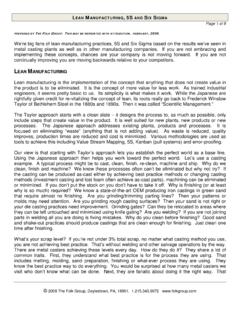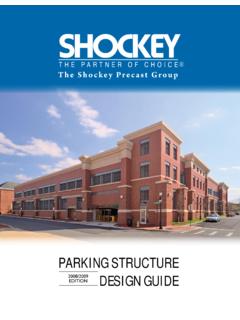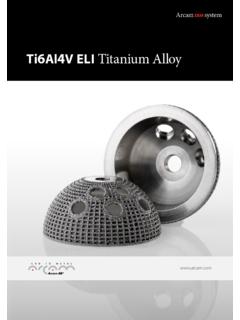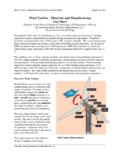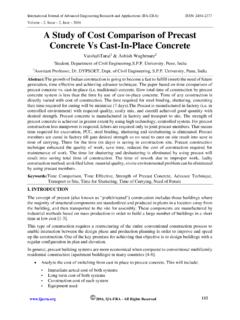Transcription of Casting cost estimation in an integrated product and ...
1 _____ *Contact address: Prof. B. Ravi, Mechanical Engineering Department, Indian Institute of Technology, Powai, Mumbai 400076, India. Phone: (+91-22) 2576 7510 Fax: (+91-22) 2572 6875 E-mail: Revised paper submitted for publication in IJCIM, Dec 2005 Casting cost estimation in an integrated product and process design environment R. G. Chougule Research Scholar, Mechanical Engineering Department, IIT Bombay, India B. Ravi * Associate Professor, Mechanical Engineering Department, IIT Bombay, India Abstract A Casting cost estimation model, driven by the solid model of the part and its attributes (material, geometric, quality and production requirements) is presented.
2 It is meant for product designers with little knowledge of the process, enabling design modifications for cost reduction in early stages, when the cost of such modifications is low. Analytical equations have been developed to estimate the cost related to material and conversion (energy and labour). A parametric model has been developed for tooling cost , driven by part complexity, which is computed from the part solid model. Parameters related to process plan and methoding/rigging (feeding and gating), required for accurate estimation of Casting costs, are semi-automatically generated by process planning and Casting methoding programs developed in our lab.
3 The programs are in turn linked to a web based intelligent collaborative engineering system called WebICE. This enables exchange of Casting project data (including cost data) among product designers, tool makers and foundry engineers over the Internet, enabling design modifications to achieve the targeted cost . An industrial example is presented to illustrate the entire system. Keywords: Casting , computer aided design, cost estimation , collaborative engineering, integrated product process design, parametric costing, solid model, web based engineering. 1. Introduction It has been well established that over 70% of the total development cost of a product is frozen during the design phase, though this phase accounts for less than 7% of the total cost (Hundal 1993).
4 Devoting more resources for early identification and prevention of potential manufacturing problems through concurrent product and process design significantly reduces the overall cost and lead-time. To aid decision-making when a choice is to be made among various alternatives for geometric, material or process parameters, an early cost estimation tool is useful and perhaps even essential. It enables product engineers to perform what-if experiments and study the effect of different designs on manufacturing cost . It can also be used during design iterations to verify if the targeted cost can be achieved (design to cost ).
5 With intensifying global competition, manufacturing cost estimation at design stage is generating considerable interest among researchers and practicing engineers. This investigation focuses on early cost estimation of cast components. Casting is an important manufacturing process and cast parts are found in 90% of manufactured goods 2and equipment (DoE, 1999). Most original equipment manufacturers (OEMs) outsource the castings from foundries. Each foundry usually specialises in a particular process (such as green sand Casting , investment Casting or gravity die Casting ), focussing on a narrow range of metals (either ferrous or non-ferrous) and applications (in terms of size/weight and geometric complexity).
6 It may have a unique combination of equipment, automation level, worker skill and past experience. The tooling (patterns, core boxes, moulds) and methoding (feeding and gating systems), which greatly affect Casting quality and yield, are designed in different ways based on knowledge gained from previous projects. These factors lead to significant variations in manufacturing cost among different foundries. Ironically, most foundries do not maintain detailed cost data, making it difficult to establish the profitability of specific Casting projects. This is becoming critical in the light of increasing pressure from original equipment manufacturers to reduce Casting prices on a continuous basis.
7 Many castings, though more economical than similar parts made by other processes, have a significant potential for further cost reduction by minor design modifications that lead to better product -process compatibility. However, with limited knowledge about Casting processes and inadequate information about the facilities and capabilities of a particular foundry, design engineers cannot be expected to accurately estimate Casting costs, especially for new products. Thus in practice, even those product designers who are aware of the benefits of early cost estimation and design-to- cost philosophy, are unable to achieve the same owing to a lack of suitable tools.
8 This paper presents our research work on developing a systematic methodology for early Casting cost estimation , suitable for design engineers. It will enable analysing the combined effect of preliminary design of product , tooling and process on cost , facilitating minor design changes to reduce cost while maintaining the desired functionality and quality. The present work focuses only on the manufacturing cost ; the cost of transportation, customs, duties, taxes and other elements affecting the price are not considered. A brief review of literature related to various approaches for cost estimation , focussing on work in Casting domain, is presented in the following section.
9 Our overall methodology is presented next, including an integrated product process design environment incorporating the proposed model for early cost estimation . Finally, the proposed approach is illustrated with an industrial example. 2. Previous work A number of cost estimation approaches are available today for estimating product cost at design stage. These include intuitive, analogical (Duverline and Castelain 1999, Wang et al. 2003), analytical (Feng and Zhang 1999), feature based (Feng et al. 1996, Ou-Yang and Lin 1997) and parametric (DoD 1999, Farineau et al.)
10 2001). The intuitive method is based on the experience of the estimator, especially with similar parts and interpretation. The analogical method involves comparison of a new product with similar existing products. Case based reasoning has been applied to improve the results of the analogical method (Duverline and Castelain 1999). The analytical method involves decomposition into elementary parts and tasks for each part, and empirical equations are used for estimating the cost of various tasks. The feature based method uses geometric features (such as slot, 3hole and rib) of the product and tooling as the basis for cost estimation .


